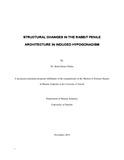| dc.description.abstract | Background: The penile body consists of erectile masses that contain vascular sinusoids lined by
endothelial cells and trabeculae which consist of smooth muscles and connective tissue fibers. The
integrity of the trabeculae and vascular sinusoids is vital in the physiology of penile erection and
so their structural alterations may result in erectile dysfunction. Androgenic hormones may be
important in maintaining this structural integrity. Accordingly, decline in androgen levels in
normal aging, androgen deprivation therapy and disorders that either damage the testes or reduce
gonadotropin stimulation are known to cause hypogonadism associated with erectile dysfunction.
However, the direct link between hypogonadism and erectile dysfunction is relatively
underexplored and the anatomical basis is altogether undescribed. Understanding of the structural
basis of erectile dysfunction following hypogonadism may inform new frontiers of investigation
and patient follow-up, in addition to giving more evidence for hormonal therapy. Alterations may
also be important when analyzing tissues from penile biopsy in various gonadal states, and in tissue
engineering for phallic grafting.
Study Objective: To describe possible structural changes in the penile smooth muscle, connective
tissue morphology and penile vascular system that may occur following gonadal androgen
hormone deprivation after bilateral orchiectomy.
Materials and Methods: Experimental animals were obtained from a rabbit farm. Fifteen adult
male rabbits were used for the study. Nine of these were castrated to induce hypogonadism
(intervention group) and six were not (non-intervention group). Surgical castration was done under
local anesthesia at the beginning of the study in the intervention group using the prescrotal
approach. Five rabbits (3 from intervention and 2 from the non-intervention groups) were perfused
three weekly from the time of castration. Penile lengths were measured using a digital Vernier
caliper (accuracy 0.5mm) at the beginning for each animal, and every three weeks until the specific
rabbit was perfused. After perfusion, tissues were fixed for a period of 24 hours in 10% formal
saline then processed for light microscopy. Masson’s trichrome stain was used to display the
smooth muscle and collagen fiber profiles, while Weigert’s elastin stain with Van Giesson
counterstain was used to demonstrate elastic fibers. Stereological techniques were used in
morphometric analysis of functional components – vascular volume in corpus cavernosum and
corpus spongiosum, smooth muscle density and connective tissue fiber components. Smooth
muscle and connective tissue contents were determined using the Cavalieri principle of point
counting and data expressed as volume densities (%). The ratios of smooth muscle and connective
tissue components were estimated from the densities of each component. The Student's t test was
applied for mean comparisons, with P-value < 0.05 considered significant. Thickness of smooth
muscle cells and connective tissue fibers was done by point sampled intercepts. Data was coded
and analyzed using SPSS Version 17.0 and presented in tables.
Results: An average reduction in the non-erect penile length by 0.7%, 3.4% and 8.7% in the
castrated group at the end of the third, sixth and ninth week respectively was noted. The volumetric
density of the trabecular smooth muscle cells of the erectile bodies decreased from a normal of
about 64% to about 12% at the end of nine weeks after castration. The proportion of collagenous
fibers to smooth muscles in the trabecular increased significantly, implying erectile tissue fibrosis
with a longer exposure to hypogonadal state. Spongiosal fibrosis was more marked than cavernosal
fibrosis. The lamella arrangement of collagen fibers in the inner layer of the tunica albuginea was
interrupted in the hypogonadic rabbits, and the inter-cavernosal septum disintegrated in the
intervention group but preserved in the non-intervention group. The amount of elastic fibers in the cavernosal trabecular system decreased with duration of hypogonadism. There was cavernosal
artery fibrosis, vascular leakage and general narrowing or collapse of subtunical vessels in the
castrated group while the integrity of these vasculature was preserved in the non-castrated rabbits.
There was progressive fat cell accumulation in the subtunical zones of the castrated rabbits,
especially after six and nine weeks of hypogonadism. Also observed was intratunical adipocyte
accumulation after nine weeks of hypogonadic state. The severity of the changes was proportional
to the duration after castration.
Conclusion: Castration induces diminutive changes in all tissue components of the penile
structure. These anatomical changes may underpin erectile dysfunction in hypogonadism.
Androgen therapy is recommended in hypogonadal states to reserve normal penile physiology. | en_US |

